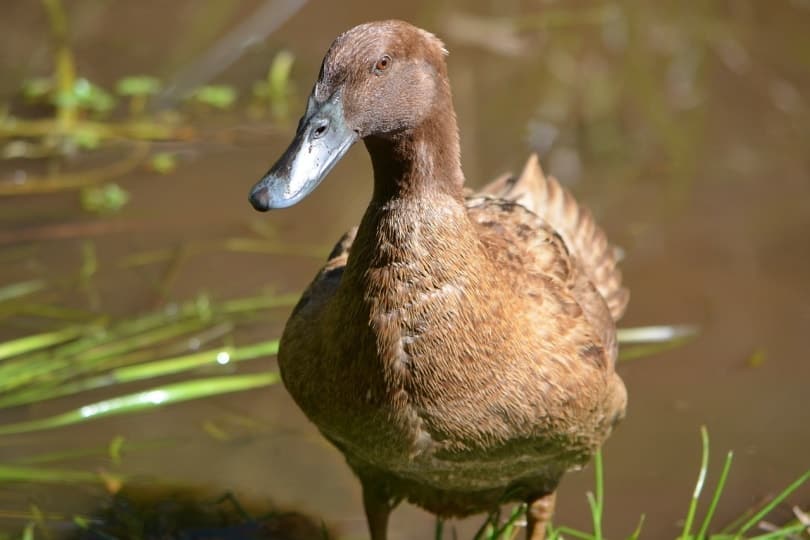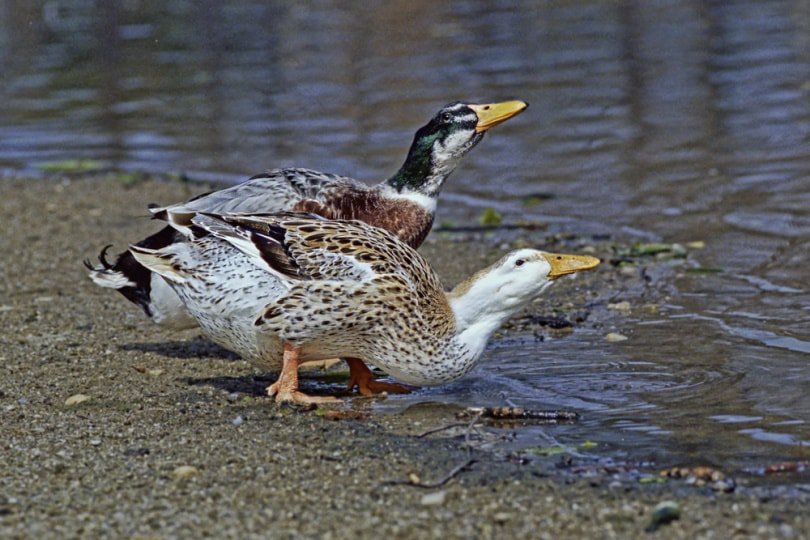Heritage duck breeds are traditional duck breeds that were raised for food in the past, but their numbers are now dwindling with the rise of animal agriculture and the reduction of species grown for the mass market. Typically, these birds are hardy and adaptable, produce high-quality meat, and are reliable and prolific egg producers.
These versatile birds are also known as multi-purpose or dual-purpose breeds because they can be used for both their eggs and their meat, as opposed to other commercial breeds that are used specifically for one or the other. While they typically grow slower than commercial breeds, they are far more useful for small homesteads and backyard keepers.
If you’re looking at adding ducks to your backyard flock, check out these five heritage duck breeds.

The 5 Heritage Duck Breeds
1. Ancona Duck Breed

| Average Size: | 5 – 6.5 pounds |
| Lifespan: | 8 – 10 years |
| Egg Production: | 210 – 280 eggs per year |
Ancona ducks are thought to have come from England but may possibly have originated in the U.S. They are known for their characteristic broken and variable plumage pattern, usually black and white. They are a rare breed, designated as critically endangered by the American Livestock Breeds Conservancy. They are prolific egg layers, typically laying up to 280 large eggs per year, and are excellent foragers that can quickly rid your yard of pests. They are one of the fastest-growing heritage breeds and can reach up to 6.5 pounds at full maturity.
2. Aylesbury Duck Breed

| Average Size: | Up to 10 pounds |
| Lifespan: | 8 – 10 years |
| Egg Production: | 35–125 eggs per year |
If you’re looking for a duck for egg production, the Aylesbury is not a great choice, laying only 125 eggs or so per year. That said, they often reach up to 10 pounds as adults, so they are great for meat production. The exact origins of Aylesbury ducks are unknown, although most agree that the breed was developed in the United Kingdom during the 18th century, when raising completely white ducks became popular. Unfortunately, the breed is listed as critically endangered, with fewer than 500 breeding pairs in the United States.
3. Khaki Campbell Duck Breed

| Average Size: | 4 – 4.5 pounds |
| Lifespan: | 10 – 15 years |
| Egg Production: | 280 – 320 eggs per year |
The Khaki Campbell was developed in England during the early 1800s, with the intention of creating a multipurpose duck breed. These ducks are far more commonly found in the U.S. than England, though, and are currently on a watchlist due to low population numbers. They were developed from Mallards, Rouen, and Runner ducks and still resemble their Mallard cousins with their khaki brown body and dark olive head. While these medium-sized birds are not kept much for meat production, they are prolific layers that produce up to 320 eggs per year.
4. Saxony Duck Breed

| Average Size: | 7 – 8 pounds |
| Lifespan: | 9 – 12 years |
| Egg Production: | 190 – 240 eggs per year |
Saxony ducks originated in Germany in the early 1930s, but after World War II, they were all but extinct. The breed was brought back from the brink and finally made it to the U.S. in 1984. The breed was created as a multipurpose bird for meat and eggs and is still used as such today. They are also popular for their beautiful feathers and commonly kept as show birds. They are still rare birds in the U.S. and are listed as threatened by the American Livestock Breeds Conservancy.
5. Swedish Duck Breed

| Average Size: | 6 – 8 pounds |
| Lifespan: | 8 – 12 years |
| Egg Production: | 100 – 150 eggs per year |
Swedish ducks originated in Sweden in the early 19th century and were imported to the U.S. in 1884. They are known for their gorgeous blue plumage and their colorful silver and black splash-patterned eggs, and they are excellent meat birds. They produce around 150 eggs per year and are suited to free-range life only, so they are ideal multi-purpose birds suited for small homesteads.

Why Keep Heritage Duck Breeds?
Heritage duck breeds are among the hardiest of duck breeds, able to adapt to various environmental conditions and typically do well in cold weather. They are also generally healthier than commercial duck breeds, more resistant to disease, and easier to care for overall. These heritage breeds are great for pest removal in your yard and are much less damaging to your plants than chickens due to their flat bills and webbed feet. They were developed as free-range animals, so they do well fending for themselves on small farms and are easy to look after.
While heritage breeds typically grow slower than commercial breeds, they still can produce plenty of eggs and meat for backyard keepers. Lastly, by keeping and breeding heritage breeds, you’ll be playing a vital part in the continuation of these often endangered ducks!
Related Reads:
Featured Image Credit: Frank Reiser, Shutterstock
